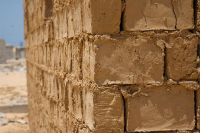








A mudbrick is a brick, made of a mixture of loam, mud, sand and water mixed with a binding material such as rice husks or straw; also known by its Spanish name adobe. Brickmakers use a stiff mixture and let them dry in the sun for 90 days.
In warm regions with very little timber available to fuel a kiln, bricks were generally sun dried. In some cases brickmakers extended the life of mud bricks by putting fired bricks on top or covering them with stucco.
The South Asian inhabitants of Mehrgarh constructed, and lived in, mud brick houses between 7000–3300 BCE.Mud bricks used at more than 15 reported sites in 3rd millennium BC are attributed as major cultural trait in the ancient Indus valley civilization. Mudbricks were in use in the Middle East during the Pre-Pottery Neolithic B period. The Mesopotamians used sun-dried bricks in their city construction, typically these bricks were flat on the bottom and curved on the top, called plano-convex mudbricks. Some bricks were formed in a square mould and rounded so that the middle was thicker than the ends. In Ancient Egypt, workers gathered mud from the Nile river, and then dug a pit and poured the mud into the pit. Workers then tramped on the mud while straw was added to solidify the mold. In Minoan Crete at the Knossos site there is archaeological evidence that sun-dried bricks were used in the Neolithic period (e.g. prior to 3400 BC).
Mudbricks were used to some extent in pre-Roman Egypt, and mudbrick use increased at the time of Roman influence.